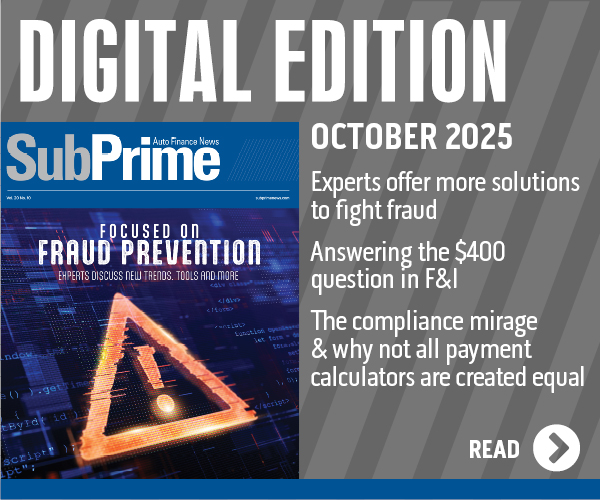Q2 delinquencies drop to lowest level in 2 years

By subscribing, you agree to receive communications from Auto Remarketing and our partners in accordance with our Privacy Policy. We may share your information with select partners and sponsors who may contact you about their products and services. You may unsubscribe at any time.
CHICAGO –
A day after the latest auto loan default data showed only marginal movement, TransUnion reported on Wednesday that its information shows the national auto loan delinquency rate declined to its lowest level in two years.
TransUnion’s auto delinquency rate — the ratio of borrowers 60 days or more delinquent on their vehicle installment contracts — dropped to 0.95 percent in the second quarter, down 3.1 percent from 0.98 percent a year earlier.
Analayts mentioned that auto delinquency rates now are at the lowest level since Q2 2013, when delinquency rates dropped to 0.86 percent.
While the overall reading is showing a positive trend, TransUnion carved out an analysis in the subprime space, too, and found similar delinquency behavior unfolding.
Delinquency rates for subprime borrowers — those consumers with a VantageScore 3.0 credit score lower than 601 — continued their steady decline, settling at 4.98 percent in Q2. The reading marked a 1.6-percent year-over-year decline from 5.09 percent in Q2 of last year.
On a quarterly basis, delinquency rates for subprime consumers declined 4 percent from 5.19 percent in Q1 of this year.
Subscribe to Auto Remarketing to stay informed and stay ahead.
By subscribing, you agree to receive communications from Auto Remarketing and our partners in accordance with our Privacy Policy. We may share your information with select partners and sponsors who may contact you about their products and services. You may unsubscribe at any time.
TransUnion found that nearly 72.5 million consumers have an auto loan or lease as of Q2 with nearly one-fifth (18 percent) of those consumers in the subprime risk tier.
Despite the 13.1 million subprime consumers with auto loans, subprime participation remains below the 23.7 percent level observed in Q3 2009 coming out of the Great Recession.
“Lenders are being prudent about re-entering the subprime lending market, and consumers are effectively managing their loans as delinquency rates remain stable,” said Jason Laky, senior vice president and automotive business leader for TransUnion.
“In today’s lending environment, we’re seeing consumers across all risk tiers take advantage of low rates. Super prime consumers, typically a group with greater wherewithal to purchase their cars for cash, are also financing their cars with more frequency,” Laky said.
Of the 72.5 million consumers with an auto loan or lease, TransUnion determined 16.8 million belong to the super prime risk tier — those consumers with a VantageScore 3.0 credit score 780 or higher. More than 23.3 percent of all auto loans are held by super prime consumers, an 8.2-percent year-over-year increase from Q2 of last year.
Viewed one quarter in arrears (to ensure the large majority of accounts are reported and included in the data), TransUnion discovered new auto loan originations increased 4.3 percent year-over-year to 6.5 million in Q1, up from 6.2 million in Q1 of 2014.
On a quarterly basis, auto originations increased 5.3 percent from 6.1 million in Q4 of 2014.
Analysts noticed auto loan debt per borrower grew 3.4 percent to $17,696 in Q2 2015. They pointed out the growth moderated across all risk tiers on a year-over-year basis, with the slowest pace of growth since Q2 2012.
“While growth rates have slowed progressively throughout the past two years, we are still in a high growth period,” Laky said. “Demand for auto loans was pent up during the Recession, and we’re seeing a return to a normal momentum.”
The youngest consumer group — individuals age 30 and younger — experienced growth in average balance for open auto trades in Q2. Up from $14,778 in Q2 of 2014, TransUnion indicated the average balance was $15,200 in Q2 of this year, an increase of $423.
Analysts went on to mention nearly 831,000 more young consumers had an auto loan in Q2 of this year than in Q2 of last year. Despite this increase, TransUnion pointed out delinquency rates remained stable from Q2 2014 (1.27 percent) to Q2 2015 (1.28 percent).
Looking at the data geographically, TransUnion noticed only two of the nation’s largest cities experienced an increase in auto loan delinquency in Q2. Houston (up 5.4 percent from 1.11 percent in Q2 2014 to 1.17 percent in Q2 2015) and Washington D.C. (up 5.1 percent from 0.79 percent in Q2 2014 to 0.83 percent in Q2 2015) experienced rises, while Boston remained unchanged at 0.59 percent for both Q2 2014 and Q2 2015.
On a state level, TransUnion reported delinquency rates in 33 states declined in Q2. Oklahoma (down 17.2 percent from 1.66 percent in Q2 2014 to 1.37 percent in Q2 2015) and Illinois (down 11.9 percent from 1.01 percent in Q2 2014 to 0.89 percent in Q2 2015) experienced double-digit declines in their year-over-year delinquency.
Analyts added that all states had an increase in auto loan debt per borrower in Q2, with New Mexico (up 5.9 percent from $20,387 in Q2 2014 to $21,586 in Q2 2015) and Georgia (up 5.2 percent from $18,312 in Q2 2014 to $19,258 in Q2 2015) experiencing the largest rises.
“The auto loan market continues to be fueled by new account growth, higher balances financed and low delinquency rates,” Laky said. “We’re observing low delinquency rates in major U.S. cities and many states, indicating a positive lending environment.”
This information is reported by TransUnion and is part of its ongoing series of quarterly analyses of credit-active U.S. consumers and how they are managing credit related to mortgages, credit cards and auto loans.


